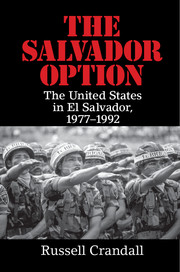Book contents
- Frontmatter
- Dedication
- Epigraph
- Contents
- List of Figures
- List of Organizations
- Acknowledgments
- 1 Introduction
- PART ONE EL SALVADOR IN THE COLD WAR
- 2 Farabundo Martí, La Matanza, and a Stolen Election
- 3 The United States in Latin America
- 4 American Military Mission in El Salvador
- 5 A Divided Nation: Military Traditions, Democratic Third Way, and Liberation Theology
- 6 Guerrillas Are Born
- PART TWO JIMMY CARTER
- PART THREE RONALD REAGAN
- PART FOUR GEORGE H. W. BUSH
- PART FIVE POSTWAR
- Notes
- Bibliography
- Index
3 - The United States in Latin America
from PART ONE - EL SALVADOR IN THE COLD WAR
Published online by Cambridge University Press: 05 June 2016
- Frontmatter
- Dedication
- Epigraph
- Contents
- List of Figures
- List of Organizations
- Acknowledgments
- 1 Introduction
- PART ONE EL SALVADOR IN THE COLD WAR
- 2 Farabundo Martí, La Matanza, and a Stolen Election
- 3 The United States in Latin America
- 4 American Military Mission in El Salvador
- 5 A Divided Nation: Military Traditions, Democratic Third Way, and Liberation Theology
- 6 Guerrillas Are Born
- PART TWO JIMMY CARTER
- PART THREE RONALD REAGAN
- PART FOUR GEORGE H. W. BUSH
- PART FIVE POSTWAR
- Notes
- Bibliography
- Index
Summary
[Washington] will not be able to hurt us if all of Latin America is in flames.
– Cuban revolutionary Fidel Castro[Latin America] reminds me of an active volcano.
– Nikita Khrushchev, Soviet Premier, 1960Examining the evolution of the Cold War is essential in grasping the ideological and geopolitical factors that underlined the sustained American engagement in El Salvador in 1980. El Salvador was an unexpected locale for deep U.S. involvement during the Cold War since, unlike many of its neighbors, it was not seen as especially prone to a victorious Marxist revolution until the late 1970s. By the early 1980s, though, El Salvador had seemingly overnight become the most likely candidate for America's “next Vietnam.” While it never ended up becoming the American tragedy that unfolded in Vietnam, El Salvador nonetheless shared many characteristics with this Southeast Asian country – at least from the standpoint of U.S. involvement.
In both instances, the United States attempted to guard against what it believed was a looming expansion of global communism. What is clear is that America's strategic and political debacle in Vietnam that officially ended in 1975 strongly influenced how the United States engaged El Salvador. America approached the country with a hefty dose of caution, given the palpable fears that El Salvador could be one more “slippery slope” resulting in a militarily maximalist, yet strategically and morally dubious, U.S.-led effort to “hold the line” against communism. But before we can fully appreciate the United States in El Salvador in the 1970s and ’80s we must first turn to two broader historical threads: the emergence of the United States’ “Big Stick” in the first half of the 20th century, when the U.S. reserved the right to intervene in the affairs of a country it deemed in disarray; and successive Cold War presidential administrations, which strove to achieve victory over communism through counterinsurgency and economic and political development.
Rise of the Big Stick
After easily defeating in Cuba what by this time was a sclerotic Spanish empire, in 1898, over the following decades the United States intervened frequently in political and economic affairs, often to combat “chronic instability” as Spanish American war veteran and president Theodore Roosevelt would characterize it while in office.
- Type
- Chapter
- Information
- The Salvador OptionThe United States in El Salvador, 1977–1992, pp. 25 - 35Publisher: Cambridge University PressPrint publication year: 2016

